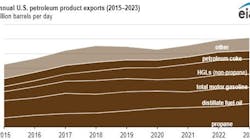In February, a number of OGJ readers received a special supplement, "Leadership in Refining," that featured pioneering articles from past issues.
Research for this supplement started with a review of OGJ indices dating back to 1924 to find pertinent articles. And while this research provided a starting point for the article-selection process, it also revealed a number of interesting trends that have occurred over the years.
One trend worth noting was the use of alcohols as gasoline additives. The debate over whether alcohols should be used in gasoline is not new. In fact, it goes nearly as far back as the gasoline industry itself.
An article entitled, "Use of Alcohol as Motor Fuel in United States Wrong Both Technically and Economically," by Gustav Egloff of Universal Oil Products Co. (now UOP), published in the Apr. 23, 1933, OGJ discussed the drawbacks and problems in using alcohol as a gasoline additive.
At that time, there was proposed legislation in the US that would impose a 10¢/gal tax on motor fuel importers or producers unless at least 10 vol % of the fuel was manufactured from agricultural products. Adjusting for inflation, that 10¢/gal figure calculates to about $1.27/gal in 2002 dollars. That legislation, had it passed, would essentially have been the equivalent of an alcohol mandate—sound familiar?
History has a way of repeating itself.
Alcohol in 1933
Amendment 18 to the US Constitution, ushered in Prohibition by prohibiting the manufacture, sale, and transportation of "intoxicating liquors." It was ratified on Jan. 16, 1919, and took effect a year later. Amendment 21 repealed Amendment 18 and was ratified by the US Congress on Dec. 5, 1933.
During this time, US farm industry's economic difficulties prompted the previously mentioned proposed legislation.
In 1933, however, technology was not advanced enough to use alcohol as a motor fuel. As Egloff states, "Many experiments have shown that the less alcohol present in the mixture, the less water is required to separate the componentsUa 2% mixture is very highly unstable."
He reported that in road tests, an alcohol-gasoline fuel showed about 10% lower gas mileage than regular-grade gasoline. The cars in that test got about 25-26 mpg but were only tested at 30 mph. Egloff also noted that the engines were harder to start and experienced poor acceleration on alcohol gasolines.
The economies of alcohol blends did not justify the fuel's use in 1933. Egloff wrote that alcohol "is more than six to eight times as costly as a gallon of gasoline sold at the refinery."
His calculation showed that because the farmers would have to use gasoline to produce the alcohol "it would be cheaper to pay [the farmer] and tell him not to grow his surplus corn at all."
The most interesting consequence of the 1933 alcohol mandate would have been a "moral" one, according to Egloff. He reported that a liquor bootlegger "would be furnished with his raw material at the wholesale cost of gasolineUabout one-quarter of what denatured alcohol used to cost him. To force the use of alcohol in motor fuel would be to make every filling station and gasoline pump a potential speak- easy."
Back to the future
Jump forward 70 years to the present—alcohol and, more specifically, ethanol in gasoline remains a hot topic of debate among US policymakers, gasoline producers, and farm lobbyists.
The current blending and engine technologies now allow ethanol blends to be technically feasible. There is, however, the continuing debate of whether ethanol should, in fact, be used in motor gasoline. Refiners agree that they can produce a clean-burning gasoline that can satisfy emission standards without adding oxygen in the form of ethers or alcohols.
And the oxygenate requirement—essentially an ethanol mandate in states that have banned the gasoline additive methyl tertiary butyl ether—has helped contribute to the high gasoline prices in the US.
Current gasoline prices are setting record high levels. The average price for regular unleaded gasoline in California, one of the states to ban MTBE, set a record of $2.18/gal on Mar. 3.
Due to low inventories and extended maintenance that some refiners are planning, any refinery upset could lead to serious price spikes during the US summer driving season.
Indeed, if history is any indication, the future should be quite interesting.

